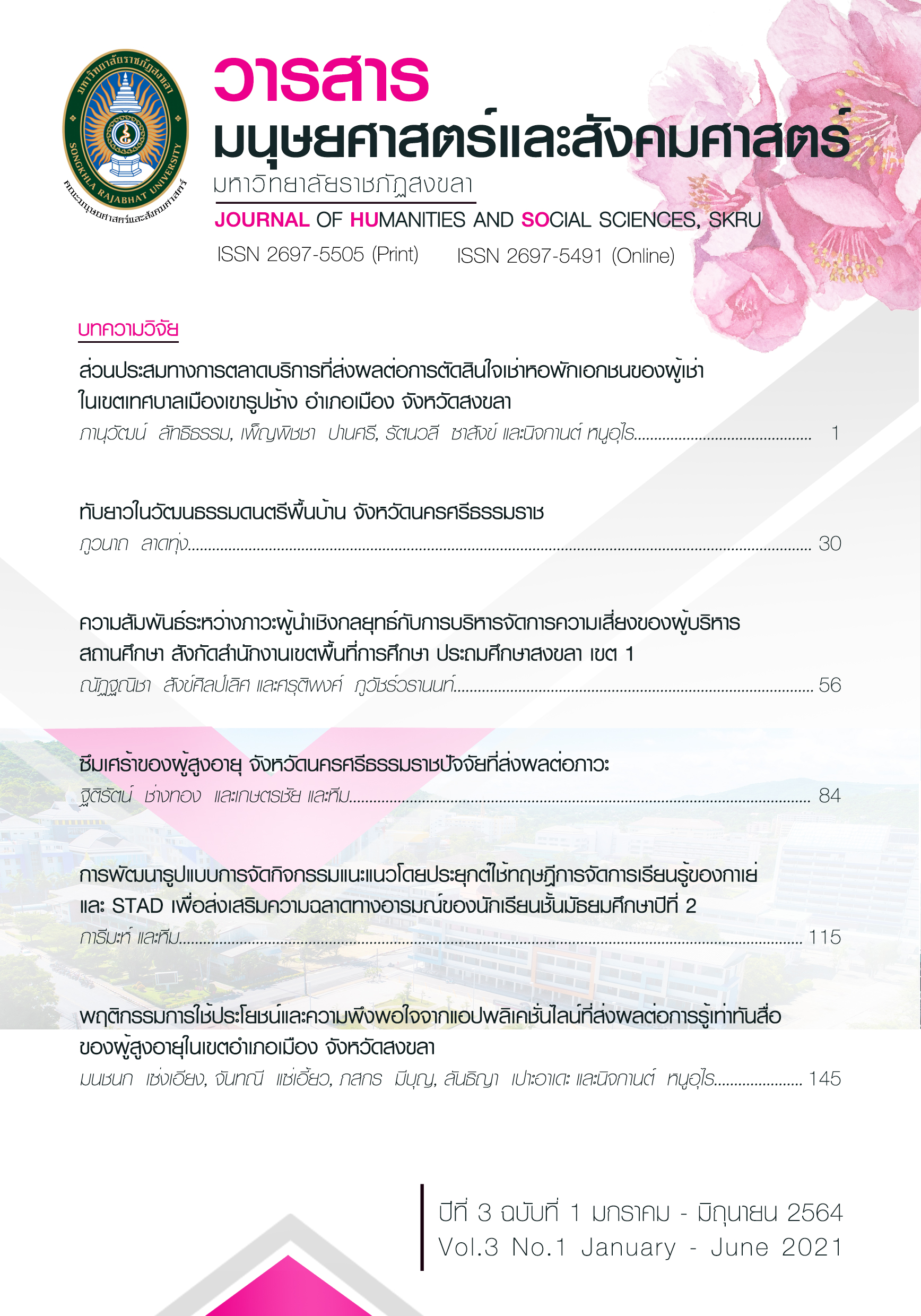การพัฒนารูปแบบการจัดกิจกรรมแนะแนวโดยประยุกต์ใช้ทฤษฎีการจัดการเรียนรู้ของกาเย่และ STAD เพื่อส่งเสริม ความฉลาดทางอารมณ์ของนักเรียนชั้นมัธยมศึกษาปีที่ 2
Main Article Content
บทคัดย่อ
การวิจัยนี้มีวัตถุประสงค์เพื่อ 1. พัฒนาและหาประสิทธิภาพของรูปแบบการจัดกิจกรรมแนะแนวโดยประยุกต์ใช้ทฤษฎีการจัดการเรียนรู้ของกาเย่และ STAD เพื่อส่งเสริมความฉลาดทางอารมณ์ และ 2. ประเมินประสิทธิผลของรูปแบบการจัดกิจกรรมแนะแนวโดยประยุกต์ใช้ทฤษฎีการจัดการเรียนรู้ของกาเย่และ STAD เพื่อส่งเสริมความฉลาดทางอารมณ์ ขั้นตอนการวิจัยมี 4 ขั้น ได้แก่ ขั้นการวิเคราะห์ (R1) ขั้นการออกแบบและพัฒนา (D1) ขั้นการทดลองใช้ (R2) และขั้นการประเมินผล (D2) ซึ่งกลุ่มตัวอย่างในขั้นที่ 3 ได้แก่ นักเรียนชั้นมัธยมศึกษาปีที่ 2/3 ภาคเรียนที่ 1
ปีการศึกษา 2563 โรงเรียนเทศบาล 1 (เอ็งเสียงสามัคคี) จำนวน 43 คน เครื่องมือที่ใช้ในการวิจัย ประกอบด้วย รูปแบบการจัดกิจกรรมแนะแนว แผนการจัดกิจกรรมการเรียนรู้ แบบประเมินความฉลาดทางอารมณ์ และแบบประเมินความพึงพอใจต่อการจัดกิจกรรมการเรียนรู้ วิเคราะห์ข้อมูลโดยการหาค่าเฉลี่ย ค่าเบี่ยงเบนมาตรฐาน ค่าการทดสอบทีแบบไม่อิสระ และการวิเคราะห์เนื้อหา
ผลวิจัยพบว่า
- 1. รูปแบบการจัดกิจกรรมแนะแนวเพื่อส่งเสริมความฉลาดทางอารมณ์ (ที่พัฒนาขึ้น) มีชื่อว่า “รูปแบบ P-Tp-A- Sr” มี 4 ขั้นตอน คือ การเตรียมความพร้อม (Preparing: P) การปฏิบัติการเรียนรู้กลุ่มย่อย (Team Practicing: Tp) การตรวจสอบผลงานและทดสอบ (Assessing: A) และการสรุปและยกย่อง (Summative and Recognizing: Sr) และรูปแบบการจัดกิจกรรมแนะแนวเพื่อส่งเสริมความฉลาดทางอารมณ์มีประสิทธิภาพเท่ากับ 83.29/86.90
2. ประสิทธิผลของรูปแบบการจัดกิจกรรมแนะแนว พบว่า หลังการเรียนรู้ตามรูปแบบการจัดกิจกรรมแนะแนว นักเรียนมีความฉลาดทางอารมณ์สูงกว่าก่อนการเรียนรู้อย่างมีนัยสำคัญทางสถิติที่ระดับ .05 และมีความพึงพอใจของนักเรียนต่อการจัดกิจกรรมการเรียนรู้อยู่ในระดับมาก
Downloads
Article Details
ลิขสิทธิ
เอกสารอ้างอิง
กรมสุขภาพจิต กระทรวงสาธารณสุข. (2550). อีคิว: ความฉลาดทางอารมณ์. (พิมพ์ครั้งที่ 4). นนทบุรี: ชุมชนสหกรณ์การเกษตรแห่งประเทศไทย.
กระทรวงศึกษาธิการ. (2553). หลักสูตรแกนกลางการศึกษาขั้นพื้นฐาน พุทธศักราช 2551. (พิมพ์ครั้งที่ 3). กรุงเทพฯ: โรงพิมพ์ชุมนุมสหกรณ์การเกษตรแห่งประเทศไทย.
จันทิมา หิรัญอ่อน. (2560). การพัฒนารูปแบบการเรียนการสอนเพื่อส่งเสริมความสามารถในการพัฒนาหลักสูตรช่างอุตสาหกรรมเชิงสร้างสรรค์. วิทยานิพนธ์การศึกษาดุษฏีบัณฑิต มหาวิทยาลัยศิลปากร, นครปฐม.
ชัยยงค์ พรหมวงศ์. (2556). การทดสอบประสิทธิภาพสื่อหรือชุดการสอน. วารสารศิลปากรศึกษาศาสตร์วิจัย, 5(1), น. 7–20.
ทศพร ประเสริฐสุข. (2551). ความเฉลียวฉลาดทางอารมณ์กับการศึกษา. วารสารพฤติกรรมศาสตร์. 5(1), น. 19–35.
ทิศนา แขมมณี. (2562). ศาสตร์การสอน: องค์ความรู้เพื่อการจัดกระบวนการเรียนรู้ที่มีประสิทธิภาพ. (พิมพ์ครั้งที่ 23). กรุงเทพฯ: สำนักพิมพ์แห่งจุฬาลงกรณ์มหาวิทยาลัย.
ธนัญญา ธีระอกนิษฐ์. (2560). จิตวิทยาพัฒนาตนในสังคมยุคใหม่. อุดรราชธานี: มหาวิทยาลัยราชภัฏอุดรราชธานี.
นะฤเนตร จุฬากาญจน์, จารุวรรณ ไผ่ตระกูล, และสุนีย์ ละกำปั่น. (2558). การพัฒนาความฉลาดทางอารมณ์ในวัยรุ่นโดยประยุกต์หลักการคิดแบบพุทธธรรม. วารสารพยาบาลสาธารณสุข. 29(1), น. 132-143.
เบญจพร ปณฑพลังกูร. (2551). การศึกษาผลสัมฤทธิ์ทางการเรียนวิทยาศาสตร์และความฉลาดทางอารมณ์ของนักเรียนชั้นมัธศึกษาปีที่ 1 โรงเรียนสาธิตมหาวิทยาลัยศรีนครินทรวิโรฒ ประสานมิตร (ฝ่ายมัธยมศึกษา) ที่ได้รับการจัดการเรียนรู้แบบร่วมมือโดยใช้เทคนิค STAD กับการเรียนรู้แบบสือเสาะหาความรู้. วิทยานิพนธ์ศึกษาศาสตรมหาบัณฑิต มหาวิทยาลัยศรีนครินทรวิโรฒ, กรุงเทพฯ.
ประวิทย์ ต้นสมบูรณ์. (2550). ปัจจัยที่ส่งผลต่อความพึงพอใจในการปฏิบัติงานของข้าราชการพลเรือนสามัญในสำนักงานเขตพื้นที่การศึกษาลพบุรี. วิทยานิพนธ์ศึกษาศาสตรมหาบัณฑิต มหาวิทยาลัยราชภัฏพระนคร, กรุงเทพฯ.
ปรียา เปจะยัง. (2562). การพัฒนากิจกรรมการเรียนรู้โดยใช้รูปแบบการสอนแบบร่วมมือกันเรียนรู้แบบ STAD ที่เน้นทักษะการแก้ปัญหา และทักษะการเชื่อมโยงทางคณิตศาสตร์ เรื่องสมการเชิงเส้นตัวแปรเดียว ชั้นมัธยมศึกษาปีที่ 1. วิทยานิพนธ์ศึกษาศาสตรมหาบัณฑิต มหาวิทยาลัยมหาสารคาม, มหาสารคาม.
ภริตา ตันเจริญ. (2561). ผลการใช้กิจกรรมการเรียนแบบร่วมมือเทคนิค STAD เพื่อพัฒนาผลสัมฤทธิ์ทางการเรียน และเจตคติต่อการเรียนวิชาวิทยาศาสตร์เพื่อพัฒนาทักษะชีวิต เรื่องระบบนิเวศ สำหรับนักเรียนระดับประกาศนียบัตรวิชาชีพ. วิทยานิพนธ์ศึกษาศาสตรมหาบัณฑิต มหาวิทยาลัยบูรพา, ชลบุรี.
ภาคินี ชูอินแก้ว, ภัทรวดี แก้วอัมพร, และเดือนเพ็ญ กชกรจารุพงศ์. (2553). การพัฒนาโปรแกรมสอนเสริมเพื่อการเรียนรู้ “โครงสร้างข้อมูลแบบต้นไม้” ด้วยหลักการสอนของกาเย่. วารสารมหาวิทยาลัยทักษิณ. 13(2), 11–27.
มาเรียม นิลพันธุ์. (2557). วิธีวิจัยทางการศึกษา. (พิมพ์ครั้งที่ 8). นครปฐม: มหาวิทยาลัยศิลปากร.
วัชรา เล่าเรียนดี. (2553). รูปแบบและกลยุทธ์การจัดการเรียนรู้เพื่อพัฒนาทักษะการคิด. (พิมพ์ครั้งที่ 5). นครปฐม: มหาวิทยาลัยศิลปากร.
สำนักงานกองทุนสนับสนุนการสร้างเสริมสุขภาพ. (2561). คู่มือพัฒนาทักษะสมอง EF Executive Functions ในเด็กวัย 13-18 ปี สำหรับพ่อแม่และครู. กรุงเทพฯ: ไอดี ออล ดิจิตอลพริ้นท์.
อุมาพร ตรังคสมบัติ. (2559). สร้างวินัยให้ลูกคุณ. กรุงเทพฯ: ซันต้าการพิมพ์.
Berger-Estilita, J. & Greif, R. (2020). Using Gagne’s “Instructional Design” to teach clinically applicable knowledge in small groups. Trends in Anesthesia and Critical Care. 35,
p. 11–15.
Calero A. D., Barreyro, J. P., & Injoque-Riclea, I. (2018). Emotional Intelligence and Self-Perception in Adolescents. Eur J Psychol. 14(3), p. 632–643.
Goleman, D. (1998). Emotional intelligence. New York: Bantam Books.
Hayatunisa, L. (2014). Student Teams Achievement Divisions (STAD) technique in teaching writing narrative text. Journal of English and Education. 2(1), p. 17-26.
Joyce, B., & Weil, M. (2009). Model of Teaching. Englewood Cliff. NJ: Prentice-Hall.
Khadjooi, K., Rostami, K, & Ishaq, S. (2011). How to use Gagne’s model of instructional design in teaching psychomotor skills. Gastroenterology and Hepatology from Bed to Bench, 4(3), p. 116-119.
Serrat, O. (2017). Understanding and Developing Emotional Intelligence. Singapore: Springer.
Slavin, R. E. (1996). Research on cooperative learning and achievement: What we know, what we need to know. Contemporary Educational Psychology. 21(1), p. 43–69.


